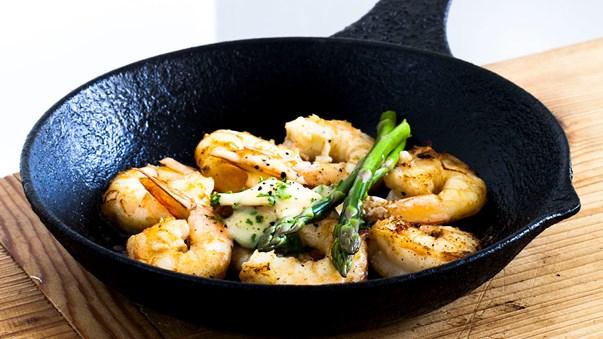Recipe: Fried Garlic Prawns with Mayo
Prawns are a fast and convenient choice of protein for the busy cook. Straight freezer, they can defrost quickly and be pan-seared to make a delicious dinner course.
Prawns can be confusing. Firstly, they are referred to as crustaceans and are also sold by size -shrimps are small and prawns are larger. There are both freshwater and marine varieties. Most prawns are imported frozen into NZ although there is growing local supply. So when you see “fresh” prawns they have generally been defrosted. Fresh prawns in many cases appear green or grey and it is only when cooked, that the colour changes to what we recognise as “pink” prawns. If you buy prawns or scrimps that are pink, this means that they have been cooked.
Then, there are a series of questions to ask:
• Do you cook them in their shells or peel before cooking?
• Do you remove the head and just cook the tail?
• Do you remove the vein (intestinal tract) or black line that runs down the back?
You can use prawns for the same recipe whether they are peeled or deveined. Many people believe that cooking prawns with the shell will enhance the flavour of the broth and result in more succulent prawn meat. The downside is that they are a bit messier to eat. To peel the prawns, you just need to wriggle them a little and ease off the shell, piece by piece.
There is no big deal about cooking prawns with the head on – it is more a cultural thing about people not wanting to see the eyes! The head pulls off easily if you twist it. The tip of the tail can be removed in the same way.
The prawn is de-veined or has the intestinal tract removed as many consider it the prawn more attractive without the black line. It also removes the prawn's stomach waste so that you do not need to eat it! See below for the method.
Like all seafood, prawns should be eaten as soon as possible and not left in the refrigerator for days. If they smell off when you come to cook them, your only choice is to throw them out!
Fried in garlic and paired with home-made mayo showcases these crustaceans at their best.
Check out the full recipe on the link below.

Today’s Mind-Bender is the Last of the Year! Can You Guess It Before Everyone Else? 🌟🎁🌲
I dance in the sky with green and gold, a spectacle few are lucky to behold; I’m best seen in the south, a celestial sight—what am I, lighting up the New Zealand night?
Do you think you know the answer? Simply 'Like' this post and we'll post the answer in the comments below at 2pm on the day!
Want to stop seeing these in your newsfeed? No worries! Simply head here and click once on the Following button.

Create a Stunning Stain Feature Wall with Resene Colorwood
Transform your living room into a work of art with Resene Colorwood wood stains. Find out how to create your own stain feature wall with these easy step by step instructions.







 Loading…
Loading…




